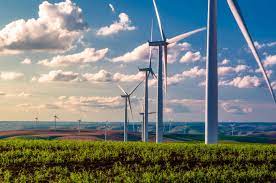On the outskirts of Baku, the smell of sulfur hangs thick in the air. Flares from oil refineries light up the night sky, a constant reminder of the industry that has dominated Azerbaijan for over a century. The country has vast, untapped potential for renewables, particularly wind and solar, which could redefine its energy future. But as the postcard images of Baku’s Flame Towers highlight, Azerbaijan’s energy outlook remains dominated by fossil fuels.
Azerbaijan has the potential to be a renewable energy powerhouse. The county’s offshore wind potential in the Caspian Sea is estimated at 157 GW – vastly exceeding its current total power capacity of 8 GW from all sources – with signed deals with Masdar and Fortescue Industries promising an additional 22 GW. Meanwhile the sun-baked Aran region, where temperatures regularly hit 40°C (104°F), could host solar farms to rival those in sunbelt countries.
Yet, these opportunities remain sidelined as the government prioritizes oil and gas. Azerbaijan has announced several renewable energy projects, but progress has been mixed. The 240-megawatt Shafag Solar Power Plant in Jabrayil District, initially announced in 2020, only began construction in late 2024, with completion expected by December 2026.
Despite years of feasibility studies, no major offshore wind farms are currently operational on the Caspian Sea. A 2019 study identified 16 potential sites for Caspian wind farms, but development has yet to commence.
While Azerbaijani officials have expressed interest in developing renewable energy – setting a target of 30 percent of the country’s power needs being generated by renewable sources by 2030 – actual progress has been slow. Key barriers include a lack of competitive electricity markets, bureaucratic hurdles for independent producers, and an unclear legal framework for private-sector involvement. Instead of creating an open and competitive market, the government has largely kept renewable energy under state control, much like the oil & gas industry.
Since gaining independence, Azerbaijan has enacted five major energy laws, but it was not until 2021 that a law specifically addressing renewable energy was passed – introducing auction and tariff systems for renewable projects. Despite incorporating auction and tariff mechanisms intended to liberalize the renewable energy market, the design of this law grants the state continued control and influence over the process.
One reason for the lack of action is that the transition to renewable energy can challenge the influence of existing state energy-sector monopolies. For instance, the Institute for Local Self-Reliance notes that concentrated power in the electricity sector can obstruct progress toward clean and cost-effective energy solutions. Embracing decentralized ownership and generation through local solar energy could give private-sector entrepreneurs, as well as local communities, a greater say in developing the clean-energy sector, thereby diminishing the influence of centralized, monopolistic utilities.
Azerbaijani officials are dismissive of critiques of their energy policies, highlighting a 2030 “green energy” roadmap and a recent agreement to supply the European Union with natural gas. Baku is also looking to export lots of electricity to the EU. In other words, Azerbaijani leaders already feel assured that they have succeeded in positioning the country as a “bridge” for renewable energy sources, even as reports circulate that the country will hike fossil fuel production by one-third over the next decade.
Ultimately, the core reason for the government’s slow approach is likely about power; political, not electric. Renewable energy’s potential to decentralize production poses a direct challenge to Azerbaijan’s authoritarian model. Unlike oil and gas – controlled by state monopolies – solar, wind, and hydro projects could empower local communities, businesses, and municipalities to generate their own energy, reducing reliance on centralized grids. Such energy independence could very well entail a reduction of government leverage over economic activity in the country.
To establish a renewable project in Azerbaijan, several steps must be followed, including obtaining land use and construction permits, securing an electricity generation permit, signing a power purchase agreement with the state-owned Azerenerji OJSC, and finally, acquiring an electricity connection permit from either vertically integrated Azerenerji OJSC or Azerishiq OJSC, both state-owned entities. Unlike decentralized models in countries like Denmark, where municipalities play a key role in approving renewable projects, Azerbaijan’s system is much more centralized: the government uses an “Atlas“ to designate renewable zones and makes final decisions, leaving little room for local input.
The auction mechanism, widely used worldwide to attract private investment, exists in Azerbaijan but operates under significant state oversight. Renewable energy producers are selected through a competitive auction, but direct procurement for strategic projects can bypass this process. Tariffs for electricity generated from renewable sources are either set by authorities or determined through auctions, with guaranteed prices specified in power purchase agreements. While this structure provides revenue predictability, it also reinforces state dominance in the sector, creating uncertainty for independent investors.
Azerbaijan’s energy transition remains stalled for several other reasons. First, oil and natural gas have long provided immediate and substantial revenue, enabling the state to fund social programs and maintain economic stability. The economy runs on a simple equation: oil + gas = instant revenue. Fossil fuels account for 90 percent of export earnings and fund nearly half the state budget. By contrast, renewable energy projects require long-term investments, often with high upfront costs and delayed returns, making them less attractive in a context where rapid financial gains are prioritized.
Second, the regulatory framework for renewables in Azerbaijan is relatively weak and remains highly state-centric. This centralization limits the development of competitive market mechanisms and independent oversight, which are essential for attracting private investment and ensuring efficient project implementation. Finally, there is a notable absence of incentives for businesses and individuals to adopt renewable energy solutions. Without financial incentives, tax breaks, or supportive policies that lower the cost of transitioning to clean energy, both consumers and private enterprises have little motivation to shift away from conventional fossil fuels.
The winds and sun of the Caspian hold immense potential, but the real question is whether Azerbaijan’s leaders will see the light.

 Iran Energy News Oil, Gas, Petrochemical and Energy Field Specialized Channel
Iran Energy News Oil, Gas, Petrochemical and Energy Field Specialized Channel



